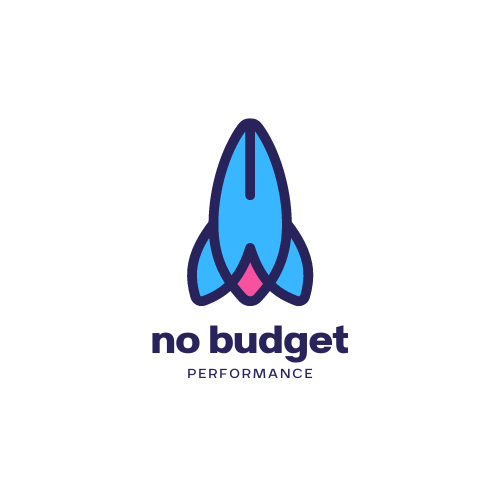Why Personal Branding Matters for Performance Artists Online
Why does getting noticed usually feel harder than the performance itself? You pour in the hours, create something brilliant, and then it disappears without an audience. The solution is personal branding for artists, which is the turning point between being overlooked and getting booked.
A strong, recognisable identity helps people remember you, trust you, and want to see more.
In this guide, we’ll cover the essentials of performance artist branding. You’ll learn how to build your look, tone, and message so they work well online.
We’ll go over practical ways to build an audience, earn trust, and stay memorable. We’ll also identify common errors and show how to avoid them.
Ready to build a brand that works as hard as you do? Let’s walk through it together.
What Is Personal Branding for Performance Artists and Why Does It Matter?
When people hear “personal branding,” many think of influencers and paid partnerships. However, for performance artists, it means creating and presenting a clear identity that reflects their creative voice, values, and visual style consistently.
That includes your social media, your website, your posters, and even how you introduce yourself. This kind of consistency helps you stand out at auditions, attract gigs, and build a following that remembers your work.
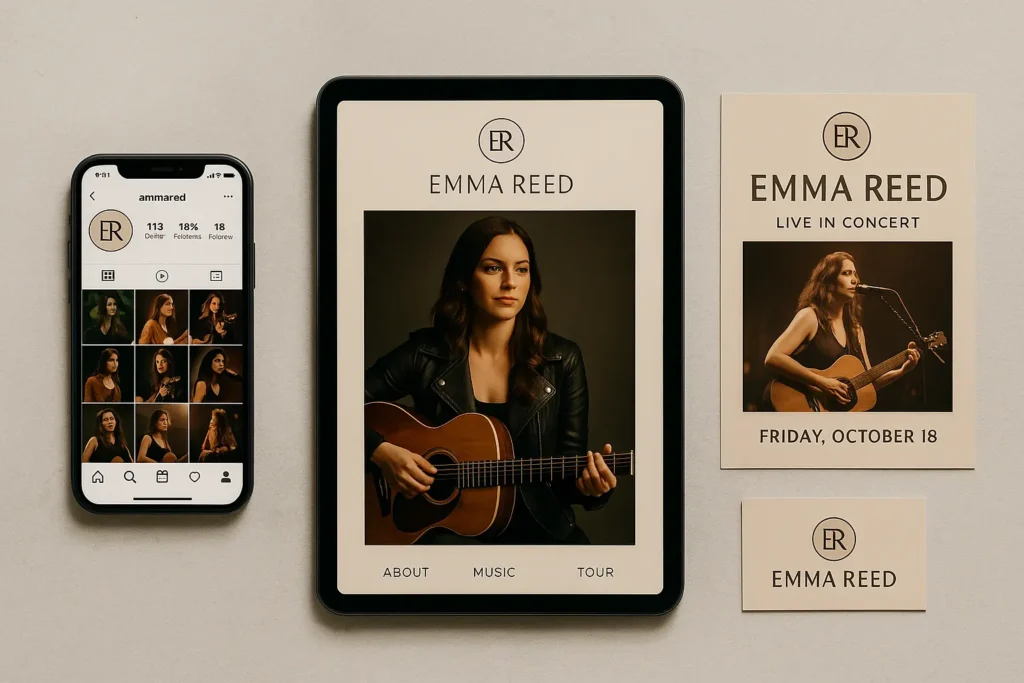
This approach works differently from traditional marketing. Rather than pushing a product or service, branding for artists creates a connection through personality and presentation.
When your audience can recognise your style and feel something genuine behind it, they are far more likely to support what you do.
A strong brand gives your work staying power, both online and off.
How to Define Your Signature Style as a Performance Artist
Once you understand the value of personal branding, the next step is to define it in a way that is unmistakably yours. A clear artistic identity gives structure to your image and makes it easier for others to recognise and remember you.
When people can describe you in one sentence, you’ve already made an impression. But how do you do it? Start by narrowing your niche. Ask yourself:
- What kind of performer are you? (Jazz singer, fire dancer, spoken word artist?) Be specific in genre as well as in the mood and energy you bring. Do you lean towards the classic, experimental, polished, or raw?
- What creative direction feels natural to you? Bold expression, subtle gestures, humour, or tension? These tendencies structure the emotional tone of your work and make it distinct.
Next, look closely at the consistent elements in your performances:
- Visual style (colours, costumes, set design): Do your visuals feel gritty, dreamy, vintage, or clean? Strong visual cues help reinforce your brand.
- Tone of voice (funny, emotional, poetic, sharp): Your delivery leaves just as strong an impression as your visuals. Pick a tone that reflects how you want your audience to feel.
- Recurring themes or values: Consider what messages or stories appear often in your work. Resilience, belonging, identity, or rebellion. Consistency here gives your art cohesion.
- Presence and movement on stage: The way you move, your posture, your energy, all create memory hooks. Some performers focus on quiet intensity, while others lead with bold and fast-paced action.
Now, prepare a one-line brand statement to bring it all together. For example, a short sentence like this should explain what you do and what makes it memorable: “I’m a Brisbane-based fire dancer uniting traditional rhythm with modern street performance.”
Use this as the skeleton for your bios, intros, and pitches to make your work instantly recognisable.
Choosing the Right Digital Platform for Online Brand Building
Every platform attracts a different kind of audience and supports different types of content. The goal is to show up where your work fits best, and it can make your performance artist branding feel stronger and more deliberate.
Instagram: Build Visual Identity and Daily Engagement
Instagram is ideal for attractive visuals, behind-the-scenes stories, and daily updates. Reels are great for short performances, while Stories can show your story.
A consistent visual style across your grid helps reinforce your brand and makes your profile feel intentional and memorable.
TikTok: Reach New Audiences with Short-Form Creativity
TikTok prevails on raw, engaging content. Short clips of rehearsals, skits, or creative takes on trends can attract new followers quickly.
Use trending sounds, hashtags, and creative editing to increase reach. It rewards experimentation and personality over perfection, which suits many performance artists well.
YouTube: Share Full Performances and Build Trust
YouTube supports longer content, which makes it great for full shows, recaps, or process vlogs. Viewers here tend to watch for longer, giving you space to share deeper insights.
Use clear thumbnails and titles to attract views, and build playlists to keep people exploring your work.
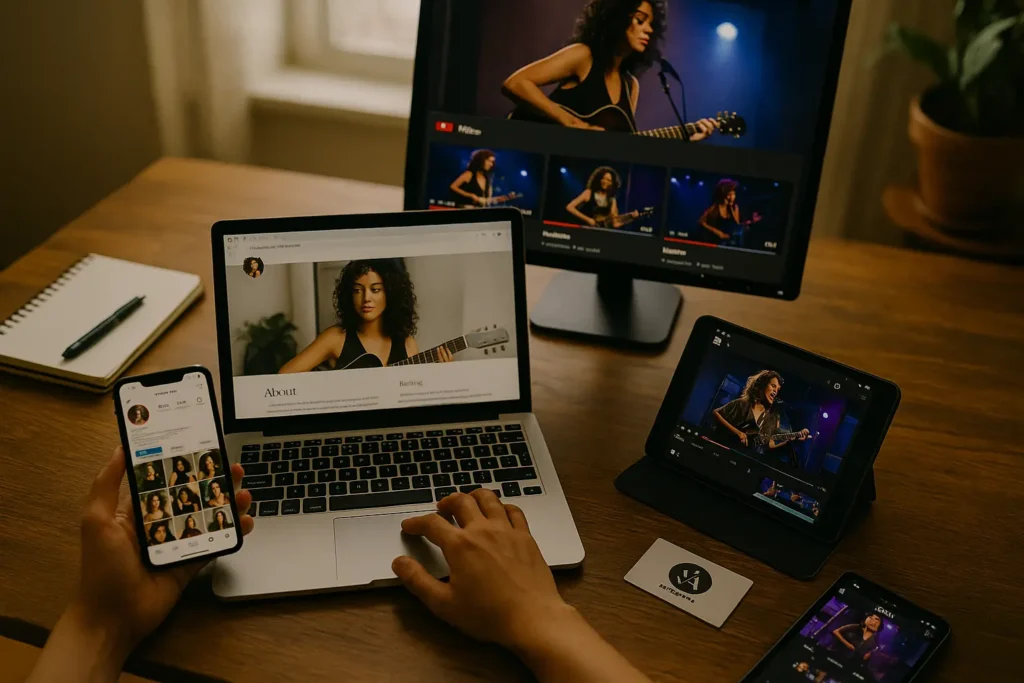
Personal Website: Centralise Your Brand and Booking Info
Your website is your professional anchor. Include your bio, showreels, testimonials, contact details, and links to social platforms. Unlike social media, this space is fully yours and doesn’t rely on algorithms.
A clear, branded site builds trust and makes it easy for people to book or refer you.
Pro tip: Avoid posting the same content word-for-word across platforms. Each one has its own rhythm, audience expectations, and strengths. Customise your content to suit the space, and you’ll connect with people more effectively.
Building Trust Through Storytelling for Performance Artists
Performers regularly share the polished moments, but those alone rarely build lasting audience loyalty. People connect when they see effort, growth, and the real person behind the act. Storytelling adds that human layer and helps your brand feel genuine.
A small glimpse into your process can influence how others relate to your work.
How to Share Your Journey as a Performance Artist
Audiences want context. They are curious about what formed your style, what challenges you faced, and how your work has upgraded over a certain time. Sharing pieces of your story helps people feel invested in what you do. Here’s how to tell your story in a way that sticks:
- Talk about your early work or first gigs: Share stories from your early days. Maybe a tiny crowd, a rough first set, or a show you almost didn’t take. These moments help others see your progress.
- Mention creative blocks and how you worked through them: Talk about moments when things felt stuck, and explain how you found momentum again. This might include support from peers, a change in routine, or even stepping away briefly.
- Share what you’ve learnt from tough shows or quiet rooms: Reflect on performances that didn’t land as expected. Show how you handled it and what insights you carried forward.
Mixing Personal and Professional Content for Artist Branding
Bringing a little personality into your feed helps people relate to you even further. A mix of creative updates and personal context keeps things grounded and authentic.
Let’s take a look at how to achieve the right balance:
- Post snippets of rehearsal or prep: Share a quick video of warm-ups, costume tests, or even a messy rehearsal. These moments show dedication and offer insight into your routine.
- Share stories or thoughts that reflect your values: If something fuels your work, like a cause, a memory, or an idea, talk about it. These details make your work more substantial.
- Keep personal updates brief but meaningful: A note about nerves before a show or pride after one creates a connection without needing a long explanation.
Using Highlights and Pinned Posts for Online Brand Building
Your digital profile is your first impression, and it’s the best way to get new clients. Story highlights and pinned posts make it easier for visitors to quickly understand what you do and why it matters.
Here’s how to use them effectively:
- Instagram Highlights to group your story into chapters: Create highlights like “First Gigs,” “Behind the Scenes,” or “Inspiration” to help people follow your journey. Each one adds structure to your profile.
- Pinned posts to spotlight origin stories or standout moments: Choose posts that reflect your voice and style. This might include a defining show, a personal reflection, or a moment that got strong audience feedback. These give new visitors a reason to stay and explore.
Case Studies: Performance Artist Branding That Worked
After talking about storytelling, let’s now look at how performers are already applying strong branding in practical ways. You don’t need a huge following or a massive budget to build something recognisable.
The examples below show how clarity, consistency, and simple creative choices can build momentum.
Viral Street Performer Branding Example
A street performer named Chloe gained traction by creating a repeatable visual experience. The audience knew what to expect, and she leaned into that familiarity across every platform.
Let’s look at what helped the brand grow.
What They Did Right
Chloe wore the same bright-blue suit in every performance and always opened with the same catchphrase. Her YouTube thumbnails had matching layouts, and her Instagram featured audience reactions, behind-the-scenes packing routines, and daily performance locations.
Lessons to Take Away
- Repetition creates familiarity across platforms
- Small details like a phrase or outfit help build recall
- Showing the full experience makes content more engaging
Circus Artist Branding with Mood and Motion
Alan, a circus aerialist, created a calm and graceful tone that formed every aspect of his brand. His work felt instantly recognisable because of a clear emotional signature rather than just flashy visuals.
Here’s what he chose to direct attention to.
What They Did Right
Alan’s branding focused on slow-motion content, soft lighting, and muted colours. He never used voice-overs or text on screen, just music and movement. His bio, logo, and highlight covers echoed the same soft feel.
Lessons to Take Away
- Movement and mood can communicate a brand without words
- Consistency in visual tone makes content instantly recognisable
- Picking one strong emotion helps set the atmosphere
Online Brand Building for Performance Poets
Adam is a poet who stood out by keeping his delivery format and message style consistent. His content had a clear rhythm, distinct visuals, and a focused message, which helped viewers connect quickly. Let’s look at how he managed it.
What They Did Right
Alan used reels to share poems on trending topics, always dressed in monochrome and using minimalist backdrops. Each post followed a rhythm like spoken word, reflective pause, and a direct call to action.
And his website included free downloads and a mailing list signup, which drove steady engagement.
Lessons to Take Away
- Aligning your visual style with your message builds clarity
- A consistent format becomes your signature
- Strong calls to action turn passive viewers into active supporters
Based on what we’ve seen, the performance artists who grow the strongest brands online are usually the ones who stay intentional. They choose visuals, voice, and timing that actually reflect who they are. That kind of consistency helps them stand out and stick in people’s minds.
Branding Mistakes Performance Artists Should Avoid
A strong brand helps artists to gain popularity, but even small blunders can create confusion and slow progress. Inconsistent visuals, outdated content, or one-sided promotion can damage your reputation. Many artists neglect these details, but they matter more than most realise.
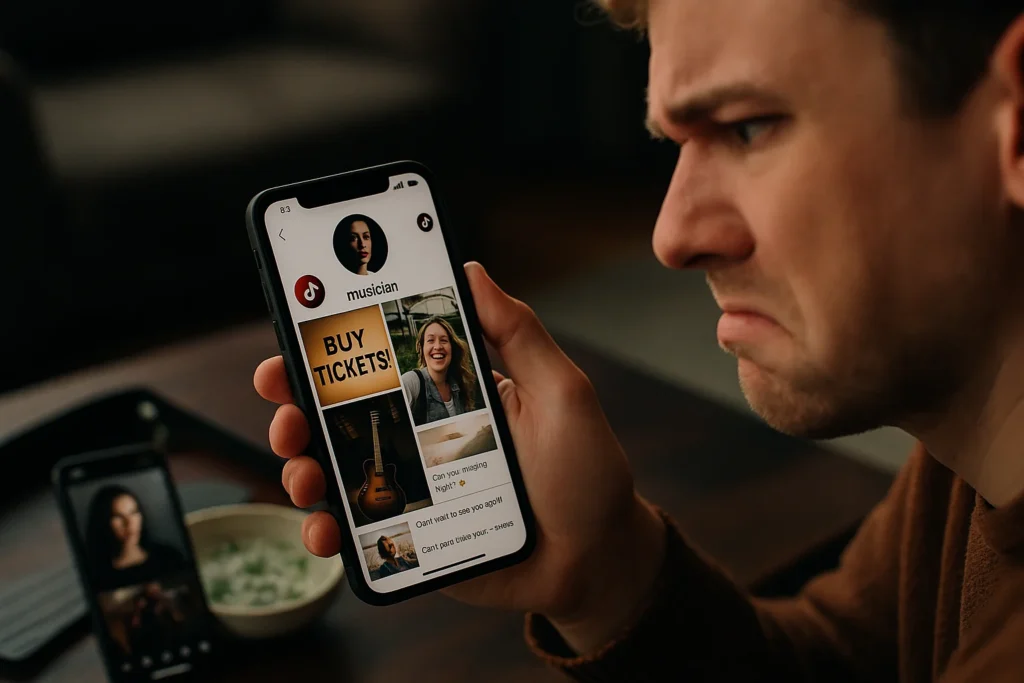
Here’s how to recognise common traps and avoid them.
Inconsistent Performance Artist Branding Across Platforms
When your tone, visuals, or message changes from one platform to another, people may feel unsure about what you represent. The clearer your presence, the easier it is to build recognition. Let’s take a look at how to keep your brand consistent everywhere.
- Use the same profile photo, artist name, and bio across all platforms.
- Stick to two or three brand colours, visual themes, or moods that reflect your work.
- Keep your captions and tone of voice aligned so your audience knows what to expect.
Consistency makes your presence more memorable and trustworthy.
Over-Promoting Without Offering Value
Promoting yourself constantly without offering anything helpful or interesting can cause people to lose interest. Content that creates interest or connection gives your audience a reason to care. Here’s how to share your work without turning people off.
- Add value by mixing in tips, behind-the-scenes content, or thoughts from your creative process.
- Share personal stories, questions, or experiences that spark emotion or curiosity.
- When you promote, give context so your audience understands why your work matters.
Balancing promotion with value keeps people engaged.
Outdated Artist Bios and Visual Branding
Old photos, broken links, or ambiguous bios can give the impression that your work isn’t active. Small details like these influence how others view your professionalism.
Here’s how to conquer this:
- Set a quarterly reminder to update your bios, links, and profile photos.
- Make sure your current focus and performance style are clearly reflected.
- Refresh your imagery so it lines up with your latest work or look.
Keeping things up to date builds trust and signals you’re actively growing.
Ignoring Engagement with Your Audience
When people reach out, comment, or share your work, they’re opening the door for connection. Ignoring those moments can push people away.
You can build trust through simple, everyday engagement, like these:
- Reply to comments. Even a short message shows you’re paying attention.
- Use polls, questions, or live sessions to invite conversation.
- Follow up with gratitude or curiosity when someone takes time to connect.
These small actions help your audience feel seen and appreciated. Over time, they lead to stronger loyalty and better word-of-mouth support.
How to Grow a Loyal Audience as a Performance Artist
Once you’ve identified the common branding mistakes, the next focus should be building steady growth. A well-paced audience improvement allows you to build real relationships instead of just attention.
When people feel a connection to your work, they’re more influenced to share it and return for more. Here are a few ways to create that ongoing interest.
- Sticky Content: Post on a consistent schedule using familiar formats like weekly performance clips, behind-the-scenes footage, short tutorials, or Q&A sessions. Predictable content helps your audience build a habit around your profile.
- Collaborations: Partner with other performers through shared videos, shoutouts, or joint events. This gives you exposure to new audiences while offering fresh content for your followers.
- Email and Membership Platforms: Use newsletters or Patreon to stay connected. Share updates, exclusive insights, or bonus material with people who’ve shown stronger interest in what you do.
Audience growth that comes from clear, intentional steps leads to more support, better engagement, and a stronger reputation in your space.
How to Track Personal Branding Success for Artists
Understanding what’s working in your branding helps you make the right moves. If you’re gaining followers but not bookings, or getting views without engagement, it might be time to adjust.
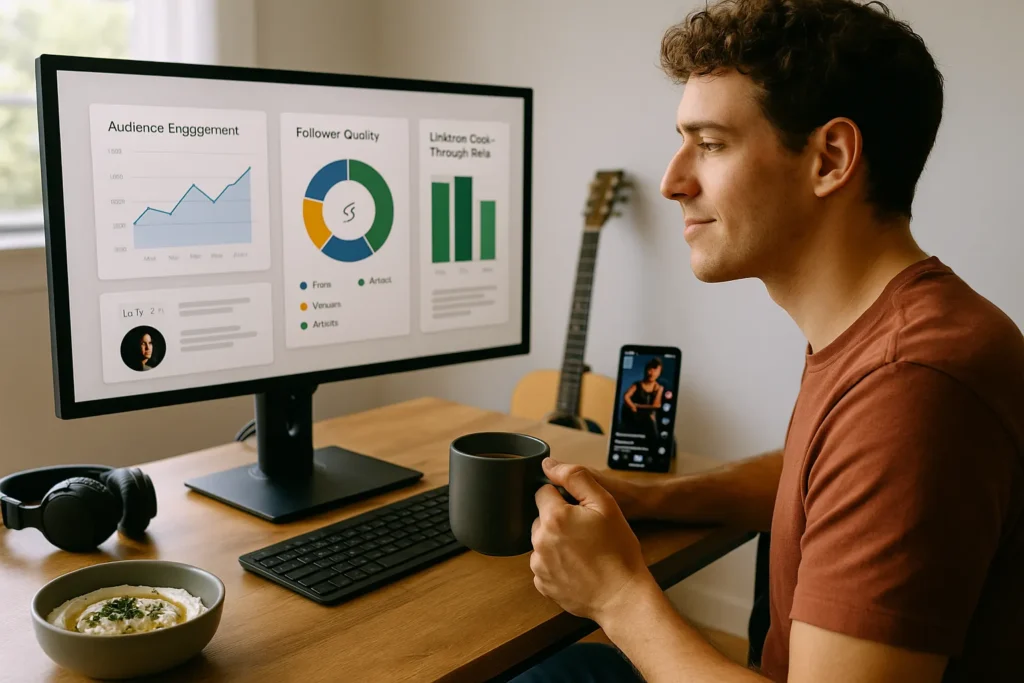
Tracking your progress gives you a clearer picture of how your performance artist branding is landing and where it needs a boost.
Here are a few metrics worth watching:
- Engagement: Comments, shares, saves, and messages show real interest. A small, active audience often does more for your brand than large numbers with no interaction.
- Follower Quality: Look at who follows you. Are they fellow artists, fans, venues, or event organisers? The right people following you are more useful than just volume.
- Repeat Bookings or Referrals: If people who’ve worked with you come back or recommend you, that’s a strong signal that your brand is doing its job.
You don’t need to check stats manually every day. Use simple tools to stay on track:
- Instagram Insights: It’s great for seeing what content performs best
- Linktree Clicks: It helps you spot which links and calls to action are working
- MailerLite or Email Platforms: They show mail open rates, click-throughs and growth trends
Refresh your branding when things feel flat or disconnected. A small update in tone, visuals, or messaging can readjust your direction without starting from scratch.
Build a Personal Brand That Gets You Booked
Your performances leave a mark, and your branding should too. A clear personal brand helps people remember your name, connect with your work, and recommend you to others.
In this post, we have learned how to define your style, share your story, choose the right platforms, grow your audience, and track your progress without losing focus.
If you’re serious about taking your brand to the next level, an eye-catching website is the place to start. No Budget Performance designs custom websites for performance artists that reflect your identity, show your work, and give people a reason to reach out.
Your audience is already searching. Let’s make sure they find the right version of you.
